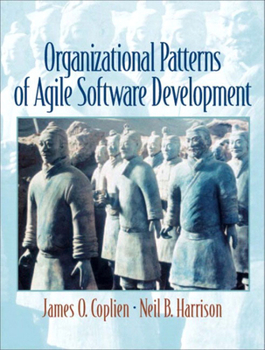Organizational Patterns of Agile Software Development
Select Format
Select Condition 
Book Overview
For courses in Advanced Software Engineering or Object-Oriented Design. This book covers the human and organizational dimension of the software improvement process and software project management - whether based on the CMM or ISO 9000 or the Rational Unified Process. Drawn from a decade of research, it emphasizes common-sense practices. Its principles are general but concrete; every pattern is its own built-in example. Historical supporting material from other disciplines is provided. Though even pattern experts will appreciate the depth and currency of the material, it is self-contained and well-suited for the layperson.
Format:Paperback
Language:English
ISBN:0131467409
ISBN13:9780131467408
Release Date:July 2004
Publisher:Pearson
Length:432 Pages
Weight:1.40 lbs.
Dimensions:0.6" x 7.0" x 9.2"
Customer Reviews
4 ratings
Finally
Published by Thriftbooks.com User , 20 years ago
This rare jewel is a practical guide to the deeper secrets and relationships of software development. It is however based on "true Science", since it was originally based on extensions to Moreno's sociometric techniques, although it reads like literature -- it is art. To the lucky ones that read it, understand it, and practice it, it will provide, undoubtedly, the passage to a higher level of understanding of how people work, and work best, when doing software devleopment. Although "agile development" pehaps was first practiced by LISP programmers in the 1960's, Organizational Patterns is perhaps the first documentation that ever existed on true Agile development. No one, to my knowledge, had done so before. (Not Scrum, which started in 1993, nor XP which started much later. etc.) To the interested readers I only have one simple advice: read every single page -- twice!!, and practice the patterns, many times!!!
Best organisational patterns
Published by Thriftbooks.com User , 20 years ago
This is the best book on patterns since the publication of Alexander's A Pattern Language. The book offers four pattern languages containing over 100 patterns that show you how to design, grow, shape and improve an organisation. The patterns are dense, full of insights, wisdom and knowledge; they are based on the authors' more than a decade of research and experience. Many of the patterns are timeless, such as CommunityOfTrust, ConwaysLaw and NamedStableBases. Some patterns are really beautiful, such as WorkFlowsInward, ArchitectAlsoImplements and FormFollowsFunction. Although the book is about organisational patterns, I have found it valuable for anyone who is interested in patterns or wishes to learn about patterns.
IT-project insights for adults!
Published by Thriftbooks.com User , 20 years ago
Patterns are good - good patterns are better - too many patterns are bad, if not presented well! Jim Coplien and Neil Harrison definitely mined good org patterns and present them in way one can digest. Many of them we had the chance of watching getting refined over years in the org pattern community so with the book you get definitely much more than what two persons could collect or research! One can get out very practical hints if one is willing to spend at least several hours with the book to grasp the ideas and underlying concepts first. Once beyond that hurdle one can harvest details and insights for years. Based on my own experiences and those of my faciltator group with several hundreds of IT-project retrospectives at Siemens Austria, regarding the concrete findings, the nice thing is, that it seems to be universal and not too culturally different what is summarized. I agree with most pattern core insights.
Common sense is so uncommon!
Published by Thriftbooks.com User , 20 years ago
It's true. There are a lot of patterns here, but most of them are just a page or two and you will remember them, not only because the patterns are well-written and the names are compelling, but because each is tellingly illustrated with a great photo! Some of these may seem like "common sense" -- especially to those of you who are great managers and team builders. Unfortunately, we know how well common sense appears at staff meetings these days :-)! Even the experts, can learn from the research that supports these patterns and some of it is surprising. The pattern "Size the Organization" recommends that teams have no more than 10 members and is one of my personal favorites. As a consultant who facilitates retrospectives across companies I can say that the penalty for not knowing these patterns can be severe. Pick up a copy and let the pictures and the prose draw you in!





